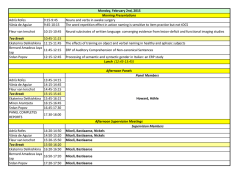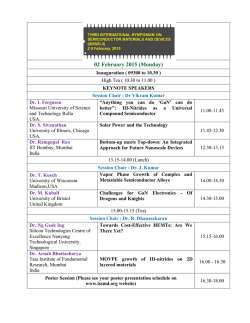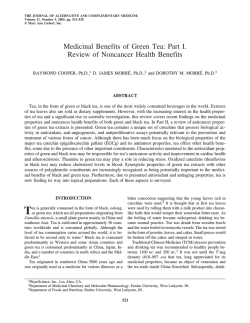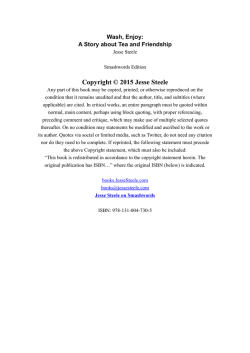
The cure for Everton Tea: A case study
Journal of Business Cases and Applications Volume 13 - January, 2015 The cure for Everton Tea: A case study Lonnie L. Bryant The University of Tampa Roshan Gunawardhana The University of Tampa ABSTRACT Everton S.P.A. is a family operated Tea company based out of the North West region of Italy. The company is currently considering a production change in order to deal with the increase in competition and decrease profit margins in the growing tea market. Many niche firms, and even large firms, find themselves reevaluating their relationships with production partners when the industry goes through changes. The purpose of this case study is to initiate the critical evaluation of the financial decision Everton S.P.A. undertook in order to evaluate the use of Glendore, a production partner. This case introduces students to the capital budgeting decision rules and the multiple methods of evaluating a project. The case is targeted for students taking an introductory course in corporate finance. The case is especially suited as a starting point for capital budgeting project evaluation. Keywords: Capital Budgeting; Decision Rules; Everton; Tea Manufacturer; Production Partner Copyright statement: Authors retain the copyright to the manuscripts published in AABRI journals. Please see the AABRI Copyright Policy at http://www.aabri.com/copyright.html. The cure for Everton, page 1 Journal of Business Cases and Applications Volume 13 - January, 2015 In July 2011, Mr. Angelo Rossi was reviewing the details regarding the Everton Tea Brand. Mr. Rossi is on the Board of Directors of Everton S.P.A, and has been asked to consider moving the manufacturing of Everton teas to India. In preparation of the next Board of Directors meeting, when the Board will discuss the details of Everton Brand, Mr. Rossi wanted to prepare the strategic rationale, the proposed value of staying with Glendore (the current production company) or transition to India and other financial considerations deemed important by the Board of Directors. INTRODUCTION: COMPANY OVERVIEW Founded in 1946, Everton S.P.A. is a tea company that was originally located in the North West region of Italy. The business has been family operated for over three generations; relying on passed-down expertise in the industry and a shared passion for tea. The collective experience of the Everton family has been tested through time by direct exposure to competition from the most prestigious countries and companies in the tea market. This stiff competition has led Everton to constantly be aware of its internal and external opportunities, such as close collaboration with local companies. The Everton company philosophy is that “quality is the best recipe for success”. This “quality” commences with the raw ingredients and continues through to finished product. It also encompasses the people, the service, favorable costs, and a partnership approach to its customers. Everton is a brand name that competes successfully with market leaders. Its current strategy is to strengthen and spread its brand name in different supply chains, focusing on mass retailers. The Everton mission is to be a dynamic and innovative company, to provide the best range of products in terms of price and quality, and to be the ideal supplier to the grocery sector by providing a value brand by servicing and developing retailers’ private labels. Everton’s product profile currently focuses on three distinct packages of tea (Table 1). While Everton has accomplished brand recognition in many markets, the company consistently works toward improving current market share and staying ahead of the curve in terms of new products. The tea market has a constantly growing and evolving customer base, and Everton desires to be innovative by providing products that match the changing needs and tastes of consumers. The company is also looking into expanding into overseas markets such as America and Australia. Glendore Ever since 1975, Everton has outsourced the production of its tea bags to Glendore, a production partner in Sri Lanka. The initial outsourcing decision was based on the favorable labor rates in Sri Lanka, the local plantation production of the tea leaves in Everton Teas, and packaging ability. Glendore has relationships with local plantations and is able to procure tea directly from the plantations as well as through tea traders. Their core competency, however, lies in the packaging of tea. Everton shares a contractual relationship with Glendore. Currently the contract between them states that Glendore annually delivers 1000 metric tons of packaged tea products to Everton. The 1000 tons of packaged goods consist of 500 metric tons of Tea Bags, 200 metric tons of Pyramids and 300 metric tons of Instant Tea. The current costs of each are $3,000, $3,500, and $2,700 per metric ton respectively. This contract is drawing to a close and will need to be re-negotiated at the end of the fiscal year. The Board of Directors must decide The cure for Everton, page 2 Journal of Business Cases and Applications Volume 13 - January, 2015 whether to begin negotiations with Glendore and establish a packaged products price or consider other alternatives. Recent Developments In 2010, Everton began experiencing problems with its tea bag production partner, Glendore. It was well-known that Glendore was experiencing several internal management issues and their reliability in the future was brought into question. In addition, the tea board of Sri Lanka had enforced stricter minimum quality standards which meant that the cost of production would soon increase. The Sri Lankan government has also increased tariffs on exports as well. The end result was that the Everton’s cost of acquiring packaged products from Glendore in Sri Lanka was becoming artificially high. As a result of these developments, it is believed that Glendore is attempting to increase the final prices of packaged products by 15%. THE ISSUE From a financial standpoint, the situation is becoming increasingly problematic. Everton’s cost of goods with Glendore is on the rise, eating into their profit margins. More importantly, they are not in a situation to pass these costs onto their retail customers, because that would cause their competitive advantage to deteriorate. The company decided to take a look at some available options. Glendore is not the sole packaging company in Sri Lanka; however they have some influence because of the fact that they have long-lasting relationships with plantations that enable them to obtain tea very efficiently. The potential to switch to another supplier exists, but the quality of tea would have to remain the same. Another option being investigated is the vertical integration of the packaging facility into the parent company. This would be a feasible undertaking because Everton has the financial ability to set up and run its own packaging facility. However, vertical integration would initially require a significant capital investment, but it would give Everton the ability to internally control both the quantity and quality of its products. With expansion in mind, Everton controlling the packaging process would allow them to ramp up production, giving them the ability to reach other markets as they have been so keen to do. The company has done some research and identified a good location for a facility in a business park in India. Everton is also certain in their ability to obtain the necessary equipment and skilled labor that would be required for the creation of a new packaging facility. Everton Tea India Facility The new facility will be funded with a $1,300,000 loan from the parent company, Everton S.P.A. The loan is to be paid back over a period of eight years at an interest rate of 4%. The construction of the packaging facility can be completed within the first six months of the next calendar year, and production can begin immediately after. The three main products to be handled by the new facility are tea bags, pyramid tea bags, and instant tea. The depreciation/ amortization schedule for the machinery and brand is provided in Table 6. The estimated sales for each product are provided in Table 2. Everton S.P.A. assumes a terminal growth rate of 2.6% after eight years. The current exchange rate is 1USD to 60.72 INR. The cure for Everton, page 3 Journal of Business Cases and Applications Volume 13 - January, 2015 The cost of goods sold (COGS) is estimated as a percentage of sales. The COGS for tea bags is expected to be 77.02% initially and will decrease by 2% every four years thereafter as the manufacturing labor gains expertise and achieves efficiency gains. For the Pyramids, the COGS is expected to start at 72.22% initially and decrease by 4% every four years that follow. The COGS for Instant tea is expected to be 75% of sales. The net working capital requirement for this facility will be $165,000. Selling, General and Administration (SG&A) expenses are essentially the facility’s fixed and variable costs. Variable costs are comprised of shipping costs, and utility costs. Shipments are made by the container load, and each container shipment costs $1,408. The projected shipment schedule for each product, and utility costs can be found in Table 3 and Table 4 respectively. A break-down of the initial fixed costs for the facility are provided in Table 5. The workforce will consist of 7 individuals for the first six months, and will expand to 14 in year one, 18 in year two, and 21 thereafter. A general manager with a monthly salary of $730 will begin working at the facility in year one. In addition, the annual accounting audit will cost $4,200. The key issue facing Mr. Rossi is to identify the relevant factors determining the benefits and costs of both options. Currently, Everton S.P.A. uses six decision rules to evaluate projects. Everton S.P.A.’s current cost of capital is 10% and the marginal tax rate is 30%. Everton evaluates projects based on Net Present Value (NPV), Internal Rate of Return (IRR), Modified Internal Rate of Return (MIRR), Profitability Index (PI), Payback Period (PB) and Discounted Payback (DPB). Everton S.P.A. requires that all projects have a payback and discounted payback less than 3years and 3.5 years respectfully. Everton and the Board of Directors have identified the necessary financials associated with setting up a new packaging facility, and wish to develop a pro forma statement in order to decide whether to set up this facility or continue doing business with Glendore. DISCUSSION QUESTIONS 1. Develop a capital budgeting pro-forma (Refer to the following Tables) 2. Evaluate the project using the following decision rules: a. Net Present Value b. Internal Rate of Return c. Modified Internal Rate of Return d. Profitability Index e. Payback Period f. Discounted Payback Period 3. Would you recommend the Everton S.P.A. board of directors building a new production facility or continue doing business with their production partner, Glendore? CONCLUSION Base on the pro forma statement created from Discussion Question 1 and the analysis from Discussion Question 2, the student should identify that four of the six decision rules suggest that building a new plant in India is financially better than keeping Glendore as a production partner. The student should discuss the merits of each decision rule and why that specific decision rule suggests that Everton S.P.A. should or should not build a facility in India. The cure for Everton, page 4 Journal of Business Cases and Applications Volume 13 - January, 2015 Faculty interested in using the case should require the teaching note from (PROFESSOR EMAIL ADDRESS). An Excel file with the Tables is also available upon request. Table 1 Product Profiles Products Destination Tea Bags Europe Pyramid Tea Bags Europe Instant Tea Italy The cure for Everton, page 5 Journal of Business Cases and Applications Volume 13 - January, 2015 Table 2 Projected Sales Sales (INR) Year Tea Bags 0 (6 months) 1 2 3 4 5 6 7 8 Pyramids Instant Tea 27,324,000 12,144,000 16,394,400 76,507,200 28,690,200 51,915,600 82,882,800 38,253,600 68,310,000 82,882,800 50,207,850 68,310,000 87,026,940 60,249,420 68,310,000 87,026,940 70,290,990 68,310,000 87,026,940 77,320,089 68,310,000 91,378,287 88,566,647 68,310,000 91,378,287 Year 95,947,201 68,310,000 Table 3 Projected Shipment Costs Container Shipments Total Tea Instant Shipments Pyramids Bags Tea 0 20 4 20 44 1 54 9 63 126 2 58 13 83 154 3 58 16 83 157 4 58 19 83 160 5 58 22 83 163 6 58 24 83 165 7 58 26 83 167 8 58 28 83 169 The cure for Everton, page 6 Journal of Business Cases and Applications Year Utility Costs ($) 0 4,600 1 2 12,525 15,125 Volume 13 - January, 2015 Table 4 Projected Utility Costs 3 4 5 19,050 19,950 20,550 6 7 8 24,675 25,375 26,075 Table 5 Fixed Costs Description Workforce Office Manager - 0 (General Manager) Office staff - 1 (Admin./ Purchasing.) Office staff - 2 (Assistant) Office staff - 3 (Admin./ Purchasing.) Qualified technician - line 1 Qualified technician - line 2 Local Director House rental (local Director) House rental (Italian Management) Cooled container rental Insurances Maintenance Units Monthly Unit Cost ($) 7 1 1 1 1 1 1 1 1 1 4 1 1 93 730 380 219 219 460 610 2,500 96 225 200 500 833 The cure for Everton, page 7 Journal of Business Cases and Applications Volume 13 - January, 2015 Table 6 Amortization Schedule Year Value of purchases Value of purchases ($) 0 1 2 3 4 5 6 7 8 Purchases Purchases Acquired Acquired Acquired Acquired Acquired Acquired Acquired 1,134,000.00 - Rate 3.24% 6.48% 6.48% 6.48% 6.48% 6.48% 6.46% 6.29% 6.04% Amortization ($) 36,745.00 73,490.00 73,490.00 73,490.00 73,490.00 73,490.00 73,221.75 71,382.00 68,506.50 The cure for Everton, page 8
© Copyright 2024



